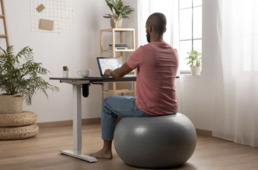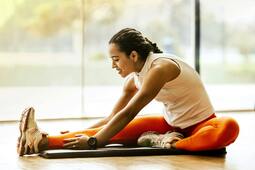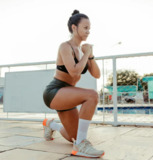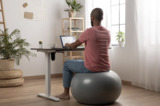
Are you spending most of your day stuck in a chair? Welcome to the modern workplace. Long hours of sitting can leave your muscles tight, affect your posture and energy levels, cause weight gain, and can create other negative health issues. Luckily, you don’t need a gym membership or any fancy equipment to combat these negative effects. A few simple movements throughout the day can make a huge difference.
Desk fitness is all about adding simple activities into your work routine. Small, intentional breaks that can help your body reset and your mind refocus. Whether it’s a quick stretch between meetings or a few desk-friendly exercises, these habits can help undo some of the damage caused by being sedentary. Here are six easy ways to stay active, boost circulation, and keep your body feeling good even when your job keeps you seated.
- Neck rolls: Slowly roll your head in gentle circles to release tension.
- Shoulder shrugs: Lift your shoulders up toward your ears, then drop them down.
- Chest opener: Clasp your hands behind your back and gently pull your arms backward to stretch your chest and undo that forward slump.
- Seated leg raises: While sitting, lift one leg at a time to activate your quads.
- Standing hip circles: Stand and rotate your hips in slow circles to improve mobility.
- Calf raises: Lift your heels off the floor and lower them slowly to get blood flowing and strengthen your calves.
Why Prolonged Sitting is a Problem
Our bodies were made to move, not sit in a chair all day. Sitting for hours, especially with bad posture, causes tight hip flexors, weak glutes, and puts a lot of stress on your back and shoulders. Over time, this can lead to neck pain, back strain, and long-term posture problems. Adding small bits of movement throughout your day will keep your muscles active, improve circulation, and help offset the damage caused by sitting too long.
Why Desk Fitness is Important
Desk fitness is simply adding short bursts of movement, like light exercises, stretches, and mobility work, into your workday. These mini-breaks loosen stiff muscles, boost energy, and even help with focus. As little as five minutes of movement every hour can make a big difference in how you feel and perform. Think of it as routine maintenance for your body: small, consistent actions that keep you strong, mobile, and pain-free.
Upper Body Stretches for Tension and Stress Relief
Sitting hunched over a computer leaves your neck, shoulders, and upper back extremely tight. Try these quick stretches at your desk:
Doing these a few times a day can ease stiffness and help you stand taller. Don’t forget to breathe during the stretches.
Lower Body Mobility
Hours of sitting can make your hips and legs tight and make you feel sluggish. A few simple movements can work wonders.
Add these in during calls or breaks, they will help!
Engage your Core
Your core helps support your posture and prevent back pain, but it isn’t often activated when sitting for long periods. To keep it working, gently draw your belly button toward your spine, hold for a few seconds, and release. Repeat several times a day. Maintaining a neutral spine and a light core engagement while sitting improves alignment and helps reduce fatigue. Bonus points, replace your office chair with an exercise ball if possible to really get your core activated!
Stretch for Better Posture
Slouching is practically a side effect of office life, but you can counter it with a few easy stretches. Stand up, reach your arms overhead, and take a deep breath. Slowly bend side to side, or place your hands on your lower back and lean back slightly to relieve pressure on your spine. These movements help reset your posture and give your back a break.
Move More, Focus Better
Move around as much as possible. Get up and walk around when you can, as long is it doesn't effect your work. Get a standing desk if possible and even better, add a walking pad. The less you sit, the better you will feel. Movement isn’t just physical, it also wakes up your brain. Stretching and light activity improve blood flow, boosting focus, creativity, and mood. You’ll likely feel more alert and less stressed after just a few minutes of movement. Desk fitness isn’t just about health; it’s also a secret weapon for productivity.
Turn Breaks into Mini Workouts
Use your breaks wisely. Take a walk, climb some stairs, or do a few squats or desk push-ups. Even standing instead of sitting for a few minutes helps. The key is to move often throughout the day, not just squeeze in a workout after hours of stillness. Frequent movement keeps your energy steady and your body happier and healthier.
Make Desk Fitness a Habit
Consistency is everything. Set a reminder every hour to stand, stretch, or move a bit. Try “movement snacks”—short bursts of activity spread through your day. Over time, these little habits add up, leaving you stronger, looser, and far less achy by the end of your workday.
Desk Fitness FAQ
1. How often should I take movement breaks during the day?
Aim for a quick stretch or bit of movement every 45–60 minutes. Even standing up for a minute or two helps reset your body and improve circulation. Set a timer if you need a reminder.
2. Do I need special equipment for desk fitness?
Not at all. Most stretches and exercises can be done right at your desk using just your body weight and a chair.
3. Can short breaks really make a difference?
Absolutely! Regular movement throughout the day reduces stiffness, boosts focus, and improves mood far more effectively than one long workout after sitting all day.
4. What if I work in a small office or shared space?
You can still fit in subtle movements—neck rolls, shoulder shrugs, seated leg lifts, or standing stretches—without drawing attention.
5. How do I make desk fitness a daily habit?
Set reminders, use apps, or pair movement with routine tasks (like checking emails or finishing calls). The goal is to make moving a natural part of your workday.
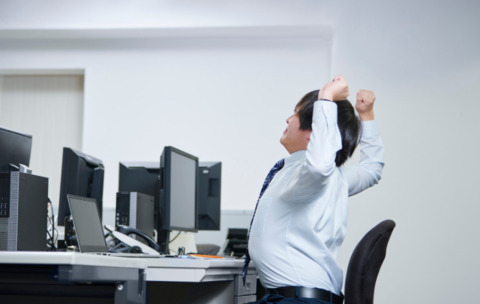
Small Movements Can Lead to Lasting Results!
Desk fitness shows that staying healthy doesn’t require a complete lifestyle makeover or a lot of time devoted to fitness. A little movement here and there makes a huge difference. Adding a few stretches or quick exercises to your workday can ease stiffness, improve posture, and give you more energy and better focus. The more you move, the better you’ll feel, not just physically, but also mentally, and even emotionally. So stand up, stretch, and breathe for a moment. Your body will appreciate it, today and for years to come.
Related posts
